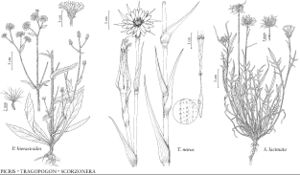Tragopogon
Sp. Pl. 2: 789. 1753.
Gen. Pl. ed. 5, 346. 1754.
| Taxon | Illustrator ⠉ | |
|---|---|---|
 | Picris hieracioides Tragopogon mirus Scorzonera laciniata | Marjorie C. Leggitt Yevonn Wilson-Ramsey Marjorie C. Leggitt |
Biennials (sometimes winter-annuals) [perennials], (15–) 50–150 cm; taprooted. Stems 1 (–5), erect, usually branched proximally, glabrous or tomentulose to floccose [lanate], often glabrescent. Leaves basal and cauline; sessile; blades linear to lance-linear or lance-attenuate (grasslike) [lanceolate to oblong], (bases clasping) margins entire (faces glabrous or tomentulose to floccose [lanate], often glabrescent). Heads borne singly (terminal). Peduncles often inflated distally (not in T. pratensis), ebracteate. Calyculi 0. Involucres campanulate [cylindric] (at flowering), mostly 10–20+ mm diam. Phyllaries usually [5–7] 8–12 [13–16] in 1 series, linear-lanceolate, triangular-lanceolate [oblong-lanceolate], linear, ± equal, margins white, narrowly pellucid, apices acute (faces glabrous [with intertwining hairs]). Receptacles convex, smooth, glabrous, epaleate. Florets (30–) 50–180+; corollas yellow or purple (proximally yellow, distally purple in T. mirus) (± deliquescent). Cypselae dark to pale-brown, stramineous, whitish, bodies ± fusiform to cylindric, usually beaked, beaks concolorous with, or paler than bodies, abrupt to gradually tapered, 5–10-ribbed (ribs usually muricate, prickly, or scaly), faces usually glabrous, sometimes scaley or muricate; pappi (usually borne on discs at tips of beaks) persistent, of 12–20+, brownish to whitish, basally connate, ± plumose, subequal to unequal awns or subulate scales, in 1 series (lateral barbs or setulae often ± intertwined). x = 6.
Distribution
Introduced; Eurasia, n Africa, in Australia
Discussion
Species 100–150 (5, including 2 amphidiploids, in the flora).
Tragopogon is weedy in North America. Allotetraploids T. mirus and T. miscellus are native to the United States. The heads of tragopogons usually open early mornings and close by midday.
Selected References
Lower Taxa
Key
| 1 | Corollas wholly or distally purple (to brownish purple in T. mirus); leaf apices straight | > 2 |
| 1 | Corollas yellow; leaf apices straight or recurved to coiled | > 3 |
| 2 | Leaf faces usually glabrous; corollas wholly purple (2n = 12) | Tragopogon porrifolius |
| 2 | Leaf faces initially tomentulose to floccose, soon glabrescent; corollas each proximally yellowish, distally purple to brownish purple (2n = 24) | Tragopogon mirus |
| 3 | Leaf apices usually recurved to coiled; peduncles usually little, if at all, inflated (at flowering); involucres urceolate in bud; outer florets equaling or surpassing phyllaries (2n = 12) | Tragopogon pratensis |
| 3 | Leaf apices straight or recurved to coiled; peduncles distally inflated; involucres conic to urceolate in bud; outer florets usually not surpassing phyllaries (2n = 12 or 24) | > 4 |
| 4 | Leaf apices usually straight (not recurved to coiled); outer florets usually much shorter than phyllaries (2n = 12) | Tragopogon dubius |
| 4 | Leaf apices usually recurved to coiled; outer florets usually slightly shorter than phyllaries (equaling or surpassing phyllaries in population from Pullman, Washington; 2n = 24) | Tragopogon miscellus |
"fine" is not a number.